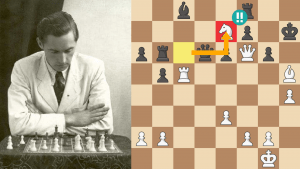
Blunders That Give Us Hidden Gold
The Chess.com member QueensConquerer wants to know what I think about his game.
JS: I’m going to be honest. This game is a total mess, with one blunder following another (from both sides). However, blunder-games are what I get from the vast majority of people who want me to critique their play. Indeed, blundering right and left is normal among online chess fans. And, as long as they are having fun, who cares if they blunder? Chess doesn’t have to make you feel like you’re back in school with a scary, shrieking teacher.
In my view, online chess addicts should take a stand:
- Just have a great time and let the blunders role! (This takes zero energy, it’s relaxing, and it’s a rush.)
- Occasionally read a few chess articles here and there in the hope of picking up some helpful tricks and information. (The same as #1, but this kind of player seeks a bit of knowledge so he can lord his newfound skills over his usual opponents.)
- Pick a rating level and strive to achieve it. (Depending on the person, this will demand anywhere from a bit of work to manic study.)

In general, I try to avoid games that offer too many blunders. But, once in a while games like that give me a window to discuss some very important lessons. This is one of them, and I thank QueensConquerer for sharing it.
Before leaping into several key points, I’ll give the whole game for those that wish to see it. However, the “gold” is in those upcoming instructive points.
I will ignore the many small errors (and quite a few blunders) and discuss more important moments.
Point One
Black has just played the poor 6...Qb4. Black’s move attacked b2, and White allowed him to take it after 7.e3. I can’t really criticize 7.e3 (though it’s dubious) since he gets some compensation due to his lead in development after 8.Rc1. Courage is something many players don’t have in chess, so I’ll give Mr. QueensConquerer a pass here.
However, White could have punished Black’s greedy 6...Qb4 (which wastes time and brings the queen into the action too early since any little thing will force the Black queen to run squealing for its life) by 7.a3! when Black’s queen can run back home in disgrace, or chop by 7...Qxb2?? only to see his queen vanish after 8.Na4. This win of a queen by Na4 is seen in various positions and is a pattern that’s worth remembering!
Point Two
White played the mistaken 14.Ra5? allowing Black to hold onto his pawn by 14...a6. Instead, White can regain his pawn with a nice position by 14.Nd4 when 14...a6 doesn’t help due to 15.Nxb5, 14...Rb8 allows 15.Rxa7, and 14...Bd7?? walks into a disaster after 15.c6 Bc8 16.Nxb5 when White has threats of 17.Nc7+, 17.Rxa7, and 17.Bxc4.
When you threaten something (like White’s 14.Ra4) make sure you look for Black’s best response. As I’ve said in other articles, amateurs tend to fall in love with their own ideas and completely ignore what the opponent is going to do. This often leads to unfortunate repercussions.
Point Three
White threatens 16.Nxb5 so Black developed his bishop with 15...Bb7, while simultaneously protecting Black’s rook, taking aim at g2, and ending White’s threat of Nxb5.
All that sounds really, REALLY good, but it’s another example of someone refusing to look for the opponent’s BEST reply (NOT the reply you want him to do!). Black should get roasted by 16.c6 when 16…Bc8 is as sad as sad can be. Then 17.Nxb5 is once again “on” and Black’s busted. Instead of 16.c6, White played the hideous 16.f3.
In a nutshell, Black insisted that White fear all the wonderful things his 15...Bb7 did (without looking to see what White SHOULD do), and White bowed to Black’s illusions and kept his g2-pawn safe (so White’s bishop can move off of f1), ignoring the things White should have done (i.e. the obvious 16.c6).
Point Four
Point Five
White’s losing (though I don’t know if either side was aware of that), so he decided to sacrifice a bishop for some pawns. Unfortunately, his 23.Bxc4?? is an instant loser after 23...Rxc5 when White should resign. Another instance of a player not looking for the opponent’s best reply. As it turned out, Black obeyed White and took the bishop.
Point Six
Black played 30…Rc6, which still wins easily but shows Black is afraid of White’s pawns (which means Black will likely play more mistakes later). Instead he could have ended the game with the crushing 30...a5! hitting the b4-c5 pawn chain at the base and following the rule: “Always attack a pawn chain at its base!”
Point Seven
(a very interesting one)
A glance would tell us that (falsely!) White’s dead and buried since Black’s e-pawn is going to run for a touchdown! However, the games a draw. See if you can find it.
Point Eight
(how I lost 10 years from my lifespan)
After 50...Kg3?????? the paramedics got to me and resuscitated the little life I had left, and I decided to continue looking at the game (I was in pain and hoped the next move would finish me off...call it “suicide by chess atrocity” or something like that). Indeed, more blunders occurred, but then SOMETHING WONDERFUL happened.
They reached a theoretical position that might prove of interest to the two players in this game and to many other Chess.com members.
FINAL POINT
(and a very important one!)
This is a theoretical win for Black. In the actual game Black didn’t know how to win it and things ended in a draw. But there’s no shame in not understanding this endgame. In fact, it’s GOOD to come across such positions since you’ll be able to look at it later and learn a very important lesson.
Allow me to share what I said in my book, Silman’s Complete Endgame Course:
I was 14 years old (with a 1600 rating) and a friend called and gave me the following position over the phone.
“White’s a queen up!” I said.
“Yes, but I bet you can’t win it.”
I laughed at him, agreed on a 50-cent wager, and I proceeded to lose my money when I couldn’t do it! Humiliated, I finally asked for the solution.
RULE: This endgame is won by maneuvering with the queen so that Black’s king is forced to step in front of its pawn. Since the pawn can’t move for a moment, the White king can take a safe step closer to the pawn’s position. This will be repeated until White’s king joins with its queen to pick off the pawn.
Once I saw how it was done (we went over it several times) he made me set up another position.
He said, “I bet you can’t win this.”
Angry at the insult, I said, “What are you talking about? You just showed me how to do it! Of course I can win it!”
He was adamant. “I’ll bet you double or nothing you can’t.”
So we went at it again:
RULES:
- A b- or g-pawn, e-pawn, and d-pawn on the seventh almost always lose to a queen.
- A c- or f-pawn on the seventh rank can draw against a queen if the stronger side’s king is far away from the action.
- That leaves the rook-pawns. White can win in most cases if his king is close to the embattled area. But if it’s a distance away, the game will usually be drawn:
SUMMING UP
- Learn basic endgames! It’s far, far more important than you might imagine.
- Before making a move, make sure you know (to the best of your ability) what your opponent’s best reply is. If that “best reply” will hurt your game, you have to toss away the move you wanted to play and look for something better.
- When the opponent plays a move that screams, “obey me!” or “you’re in trouble! Run! Run!” do NOT listen to him! Never, ever believe what your opponent is (psychically) telling you.
- Always attack a pawn chain at its base! (Keep in mind that all rules can and should be broken from time to time.)






